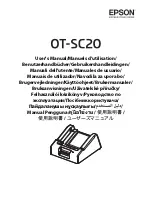
6 • EN
DESULPHATION
SOFT START
BULK
ABSORPTION
ANALYSE
RECOND
FLOAT
PULSE
V
OL
TA
GE (V)
11
7
2
3
4
5
6
8
CURRENT (A)
NORMAL
15.8V
120A until 12.6V
Increasing voltage to
14.4V
Max 120A
Declining current
14.4V
Checks if voltage
drops below
12.0V
13.6V
120A
12.7V–14.4V
30A–3.0A
AGM
15.8V
120A until 12.6V
Increasing voltage to
14.7V
Max 120A
Declining current
14.7V
Checks if voltage
drops below
12.0V
13.6V
120A
12.7V–14.4V
30A–3.0A
Ca/Ca
15.8V
120A until 12.6V
Increasing voltage to
14.7V
Max 120A
Declining current
14.7V
Checks if voltage
drops below
12.0V
Max 15.8V
3.0A
Initial voltage
>12.3V = 2 hours,
otherwise 6 hours.
13.6V
120A
12.7V–14.4V
30A–3.0A
Limit:
8 hours
20 hours
16 hours
3 minutes
24 hours
(Power Supply
unlimited time)
Max 1h pulse
STEP 1 DESULPHATION
Detects sulphated batteries. Pulsing current and voltage, removes sulphates from the
lead plates of the battery restoring the battery capacity.
STEP 2 SOFT START
Tests if the battery can accept charge. This step prevents charging a defective battery.
STEP 3 BULK
Charging with maximum current until approximately 80% battery capacity.
STEP 4 ABSORPTION
Charging with declining current to maximize up to 100% battery capacity.
STEP 5 ANALYSE
Tests if the battery can hold charge. Batteries that cannot hold charge may need to be
replaced.
STEP 6 RECOND
Select the Ca/Ca program to add the Recond step to the charging program. During the
Recond step voltage increases to create controlled gassing in the battery. Gassing mixes
the battery acid and gives back energy to the battery.
STEP 7 FLOAT
This step maintains the battery voltage by providing a constant voltage charge.
STEP 8 PULSE
Maintaining the battery at 95–100% capacity. The charger monitors the battery voltage
and gives a pulse when necessary to keep the battery fully charged.
WAKE UP
Safely bypasses the discharge protection if active on the battery.
STEP 1 ACCEPT
Tests if the battery can accept charge. This step prevents that charging proceeds with a
defect battery.
STEP 2 BULK
Charging with maximum current until approximately 90% battery capacity.
STEP 3 ABSORPTION
Charging with declining current to maximize up to 95% battery capacity.
STEP 4 ANALYSE
Tests if the battery can hold charge. Batteries that can not hold charge may need to be
replaced.
STEP 5 COMPLETION
Final charge with increased voltage.
STEP 6 MAXIMIZATION
Final charge with maximum voltage up to 100% battery capacity.
STEP 7 FLOAT
Maintaining the battery voltage at maximum level by providing a constant voltage
charge.
STEP 8 PULSE
Maintaining the battery at 95–100% capacity. The charger monitors the battery voltage
and gives a pulse when necessary to keep the battery fully charged.
CHARGING PROGRAMS LEAD-ACID BATTERIES
CHARGING PROGRAMS LITHIUM BATTERIES
WAKE UP
ACCEPT
BULK
ABSORPTION
ANALYSE
COMPLETION
MAXIMIZATION
FLOAT
PULSE
V
OL
TA
GE (V)
CURRENT (A)
Lithium
14.4V
1A
11.0V
120A
120A until
13.8V
13.8V Decreasing
current and intel-
ligent time control
Checks if voltage
drops below 12.0V
14.4V
Max 3.0A
13.3V
120A
Cycle start at 12.8V
13V–13.8V
15A–3.0A
Cycle start at 12.8V
Limit:
25 s
Max
10 minutes
Max 20 hours
Max 4 hours
3 minutes
If start charge voltage less than
13.9V then max 2 hours
Max 24 hours
Max 1 hour pulse
Auto pulse
10 days
1
7
2
3
4
5
6
8
50016574B CTEK PRO 120A, Manual, Print file_016.indd 4
2017-11-30 11:14:06























